Understanding Urine Spots on Lawns: Causes and Solutions
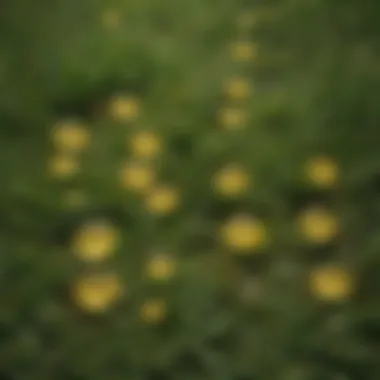
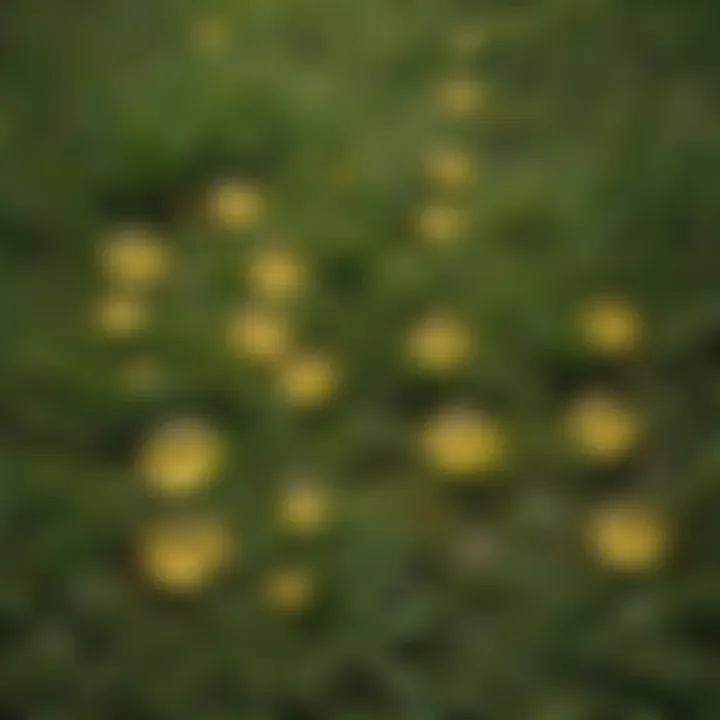
Intro
When it comes to keeping a lawn lush and vibrant, few things can throw a wrench in the works like unsightly urine spots. These patches, often yellow or brown, can leave even the most devoted gardener scratching their head in confusion. Understanding the origin and implications of these unpleasant markings is essential for those aiming for a pristine outdoor space. This article delves into the science behind urine spots on lawns, casting light on their causes, effects, and potential remedies.
Topic Overview
Definition and Importance
Urine spots on lawns are the result of nitrogen overload primarily from dog urine. The high concentration of nitrogen in urine, which is great for crops in controlled amounts, wreaks havoc when deposited onto grass in larger quantities. Think of it like a double-edged sword—while nutrients are essential for plant health, too much can lead to some unexpected consequences. Recognizing this will help homeowners and pet owners take actionable steps to minimize damage.
Brief History and Evolution
The issue of urine spots isn't new; in fact, it has been acknowledged for decades. Research has shown that certain grasses are more tolerant of nitrogen than others. Historically, pet owners often dealt with these spots by planting different types of grass or even employing landscaping tricks that have been passed down through generations. However, with advancements in lawn care and a deeper understanding of soil chemistry, new methods have emerged to tackle this enduring problem.
Key Techniques and Innovations
Sustainable Farming Practices
One of the most effective methods to combat urine spots is integrating sustainable practices into lawn care. Here are some strategies:
- Soil Health Improvement: Regularly testing and amending soil can create healthier living conditions for grass. Using organic matter can buffer against nitrogen overload.
- Diverse Planting: Embracing a mix of grass species fosters resilience. Some breeds, like fescue and zoysia, possess more forgiving traits against nitrogen concentration.
- Watering Techniques: Proper watering can dilute the effects of urine. Consider watering your lawn shortly after your pet does the business. It helps wash away excess nitrogen and restores balance.
Advanced Agronomic Technologies
Recent technological developments, like advanced sensors for soil monitoring, are changing the game for lawn care. Strategies such as:
- Smart Irrigation Systems: These systems use weather data and soil moisture levels to optimize watering schedules, ensuring grass receives the right amount of water to counteract nitrogen spikes.
- Fertility Mapping: Tools that analyze nutrient distribution in lawns can pinpoint areas suffering from nitrogen burn and inform targeted treatments.
Practical Applications
Step-by-Step Guides
- Assess the Damage: Identify spots in your yard affected by urine. Check for discoloration and size to see how extensive it is.
- Test Soil: Grab a soil test kit from your local garden center. Analyze nitrogen levels and soil pH to find the underlying issue.
- Adjust Care Plan: Based on your findings, decide if you need to overseed, amend the soil, or implement different watering methods.
- Implement Solutions: Plant more robust types of grass, incorporate compost, or redesign your watering schedule to lead to healthier green spaces.
Case Studies or Real-World Examples
In a recent case documented at a community park in Michigan, local officials observed extensive urine spots created by a popular dog park area. After analyzing the situation, they decided to plant a mix of hardy grasses more tolerant to urine. Following their implementation of sustainable lawn care practices, they drastically reduced the visibility of urine spots while maintaining an inviting space for pets and their owners.
"We found that adopting a holistic approach not only improved the lawn health but also encouraged community engagement in lawn care," said a local park manager after the successful implementation.
The key takeaway from this example is the importance of adapting lawn management strategies to address the specific challenges posed by pets, underscoring that knowledge can go a long way in fostering a healthy lawn.
By understanding the complexities surrounding urine spots, pet owners and lawn caretakers alike can obtain a sense of mastery over their growing environments. Knowledge, once cultivated, can lead to lasting solutions that ensure both pets and lawns thrive together.
Prolusion to Urine Spots
Nature of the Problem
Urine spots are not just unseemly blemishes on an otherwise idyllic landscape—they're a testament to the chemical interactions happening beneath our feet. When pets relieve themselves, their urine contains a cocktail of nitrogen, salts, and other compounds that can wreak havoc on grass. Grass is particularly sensitive to these elements, leading to brown patches or even dead spots if not managed correctly. Too often, homeowners treat these marks as mere inconveniences, failing to grasp the underlying science.
Each patch of dead grass tells a story of chemical imbalance. The concentrated exposure to nitrogen in the urine can cause what many refer to as “grass burn.” This phenomenon occurs when the concentration of nitrogen overwhelms the grass's ability to process it, leading to rapid cellular damage. Think of it as the lawn’s version of a hangover—too much of a good thing can turn bad quickly.
Importance of Lawn Care
Why should we be concerned about these spots? Beyond the visual disappointment, neglecting proper lawn care can lead to greater issues down the line, such as soil degradation and nutrient imbalances. A well-maintained lawn serves as a natural carbon sink, supporting local ecosystems. It fosters biodiversity and contributes to a healthier environment overall. A vibrant lawn can also enhance property value and create a welcoming outdoor space for family and friends.
For pet owners, there's an added layer of responsibility. Ensuring the health of a lawn while navigating the considerations of pet behavior necessitates a proactive approach. The right lawn care techniques not only mitigate the impact of urine spots but also create a more resilient and aesthetically pleasing environment. It may require some effort, such as training pets or adjusting watering schedules. However, the benefits extend far beyond a lush green carpet; a well-cared lawn is a testament to the harmony between people, pets, and nature.
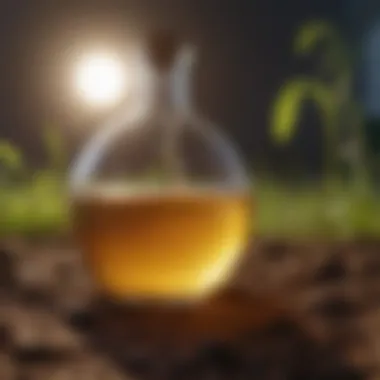

"Healthy lawns reflect the determination of caretakers. Investing time in understanding their needs can lead to a landscape that truly flourishes."
Chemical Composition of Urine
When delving into the landscape of lawn care, understanding the chemical composition of urine is crucial. It's not just a quirky nuisance; it holds significant implications for soil and grass health. The elements found in urine interact with the environment, making their roles multifaceted. Knowing what's in it allows lawn caretakers to devise effective strategies to counteract the damage and promote recovery.
Key Components
Nitrogen
Nitrogen is the heavyweight champion when it comes to grass growth. It is an essential nutrient that plays a vital role in the development of chlorophyll, which is what gives plants their green color. Its abundance in urine provides a rapid boost to grass, making it a common cause of vibrant patches where the urine has pooled.
However, it's a double-edged sword. While nitrogen feeds the plants, excessive amounts can lead to grass burn, characterized by brown or yellowing patches. This happens because high nitrogen levels can overwhelm the grass, essentially “burning” it. It's important to monitor how much nitrogen is pouring onto the lawn, especially in areas frequented by pets. This component showcases the balance: potential growth versus potential damage.
Phosphorus
Phosphorus serves as another critical player in the team. It plays a pivotal role in root development and energy transfer within the plant. When properly utilized, phosphorus enhances a grass's resilience and overall health. This can help establishments take root deeper into the soil, which is crucial for sustaining a lush lawn.
However, there's a caveat. The key characteristic of phosphorus is that it should be kept in check. Over-application can lead to runoff, which may harm local waterways. It’s a fine line to tread. Understanding how much phosphorus is in urine can help in managing its levels thoughtfully, ensuring there are no collateral damages.
Potassium
Potassium is often viewed as the unsung hero in this chemical lineup. It helps in regulating water, enhancing drought resistance, and enabling overall plant vigor. Grass infused with potassium often shows greater resilience against pests and diseases. This makes it a beneficial aspect of urine, offering protection where it’s needed.
Yet, much like its counterparts, potassium can also create problems in excess. High levels can cause an imbalance in nutrient uptake, overshadowing the grass's ability to absorb calcium and magnesium, which are equally vital. Hence, while potassium holds significant promise for enhancing lawn health, it should not be taken for granted. It is prudent to understand its specific role and manage it wisely in the context of lawn care practices.
pH Levels
The pH levels of the urine also play a part in how these nutrients affect lawn health. The pH can shift depending on the dietary habits of pets, with some diets leading to more acidic urine. A balance between acidity and alkalinity is paramount for optimal nutrient absorption by the grass. High acidity can hinder plant nutrition; conversely, too much alkalinity can lock out essential nutrients.
In summary, understanding the chemical makeup of urine not only highlights its potential benefits but also its pitfalls. By tailoring lawn care strategies around these elements, caretakers can mitigate damage and foster a healthier environment for their grass, ensuring a lush and resilient green space.
Effects of Urine on Grass
Understanding how urine affects grass is crucial for any lawn caretaker. The condition of your grass ultimately reflects the overall health of your lawn. Knowing how to recognize and remedy issues caused by urine can save you a lot of time and effort in maintaining a vibrant lawn. From burns to nutrient overload, the effects can vary greatly, prompting careful consideration of how to handle damages.
Grass Burn
Grass burn is a common result when urine from pets lands on the same patch of grass repeatedly. The high concentration of nitrogen in urine can cause the grass blades to wilt and eventually turn brown. This is especially noticeable during dry spells when the grass is already under stress. To make matters worse, the distinction between healthy grassy areas and burned patches can be quite stark, disrupting the aesthetic of your lawn.
In some cases, however, this "burn" can be more pronounced with certain grass species. For instance, fescue grass is often more susceptible to urine burns compared to Bermuda grass.
Nutrient Overload
While nitrogen is essential for grass growth, too much of it can lead to nutrient overload. This is akin to over-fertilizing, where the grass receives more nutrients than it can process. This condition can cause uneven growth, leading to patches of grass that flourish while others struggle. In other words, if you let things go unchecked, you might end up with a lawn that looks like a patchwork quilt, where some areas are lush and green, and others are sad and wilted.
Important Note: Balanced nutrition is important. Excessive primary nutrients can drown out necessary secondary nutrients, compromising grass health.
Possible Recovery
When it comes to recovering from urine spots, there are several strategies that can help restore your lawn to its former glory. Recovery is not just about addressing the current issues; it's also about preventing future problems.
Strategies for Lawn Repair
Implementing effective lawn repair strategies can significantly contribute to the health of your grass. Aeration is a popular choice; it helps to break up the compacted soil and allow air, water, and nutrients to penetrate deeper. Another strategy is to regularly rotate your pet's bathroom zones, which helps in minimizing concentrated damage over the same areas. The key characteristic of these strategies is their ability to repair and rejuvenate the lawn over time. Many homeowners report benefits from combining these methods for a more holistic restoration approach.
Timing and Seasons
Timing plays an important role when it comes to lawn repair. The best time to perform restorative actions, like reseeding or aeration, is usually during the growing season when grass can flourish. For example, early spring and fall are typically regarded as prime periods for these types of interventions. The unique feature about timing lies in its impact on recovery speed; tackling these problems while grass is actively growing can result in quicker recovery and less stress on the grass overall. On the flip side, attempting to repair burnt patches in the heat of summer might not provide the desired outcomes, leading to potential disappointment.


Overall, recognizing the effects of urine on grass involves understanding both immediate damage and longer-term health strategies for your lawn. By learning how to mitigate these issues, one can keep a lush, green yard that both pets and owners can enjoy.
Preventing Urine Spots
Preventing urine spots on lawns is crucial not just for visual aesthetics but also for maintaining overall grass health. A patchy lawn can be a sore sight, signaling to neighbors and guests that lawn care may not be your top priority. More importantly, a healthy lawn contributes to the local environment and offers a habitat for various species. Therefore, addressing this issue early can save one from larger headaches down the line.
Training Pets
One of the most effective strategies for preventing urine spots involves training pets. Dogs, for example, are often the primary culprits behind these unsightly patches. The goal is to condition your furry friends to minimize their impact on the lawn.
A common method includes designating specific areas for pets to relieve themselves. Using positive reinforcement can encourage this behavior. When a pet goes in the right spot, offer praise or a treat. Over time, they will learn to associate that area with relief.
Selecting Resistant Grass Types
Not all grasses are created equal when it comes to tolerating pet urine. Selecting resistant grass types can be a game changer. Some varieties, like tall fescue or Kentucky bluegrass, exhibit more resilience to nitrogen overload from urine.
When choosing grass, consider two primary factors:
- Drought Resistance: A hardy grass will survive stressful weather conditions, which can be beneficial during dry spells.
- Regrowth Ability: Grass that can recover quickly from wear and tear stands a better chance against urine damage.
Additionally, consult local gardening experts or extension services, as they usually have insights into which grass works best in your region.
Lawn Maintenance Practices
Proper lawn maintenance can also play a pivotal role in mitigating the impact of urine spots. Simple practices can add up to significant changes.
Watering Techniques
When discussing watering techniques, the highlight is the timing. Watering your lawn early in the morning helps the grass absorb moisture before the sun rises high. This technique provides a buffer against urine spot development by diluting the nitrogen concentration more effectively than if the lawn was watered later in the day.
Key Characteristics:
- Frequency: Regular watering establishes a routine that conditions the earth.
- Depth: Ensuring deep watering encourages roots to grow stronger, making the grass less susceptible to damage.
However, be careful of overwatering. Too much water can create a swampy environment, leading to different issues like mildew or root rot.
Fertilization Controls
Controlling the level of fertilizer is another essential component. Over-fertilization, particularly with high nitrogen content, can worsen the effects of urine spots. Implementing a gradual fertilization plan, instead of a heavy application at once, is advisable.
Unique Feature:
- Consider slow-release fertilizers which do not flush nutrients into the soil all at once. They release nutrients over time, allowing grass to absorb them without forcing an overload.
Balancing fertilization will allow the lawn to recover from any urine trauma while keeping it lush and green. None of these options are foolproof without consistent vigilance and care.
"An ounce of prevention is worth a pound of cure."
Keeping on top of these practices can dramatically improve both lawn attractiveness and health.
Mitigating Damage
Mitigating damage from urine spots on lawns is critical for several reasons. First off, these patches can create an unsightly view, hampering the overall appeal of a landscape. Secondly, improper handling can lead to long-lasting effects on soil quality and grass health. To bounce back from these trouble areas, individuals need to understand a few essential approaches that can effectively minimize damage and restore their green spaces to full glory. Strategically addressing urine spots can ensure that the lawn stays lush and vibrant, making it a welcoming spot for family, friends, and guests.
Applying Gypsum
Applying gypsum is one technique many lawn caretakers utilize when dealing with spots caused by urine. It's important to grasp that gypsum, primarily composed of calcium sulfate, can work wonders for a lawn's soil structure. By adding gypsum, essential elements like calcium become available, which can help counteract the damaging effects of excess nitrogen and improve drainage.
- Benefits of Gypsum:
- Helps reduce soil compaction, allowing air and water to reach deeper levels.
- Neutralizes excess sodium ions that may interfere with the natural balance of nutrients.
- Encourages better root development, ultimately leading to a denser lawn.
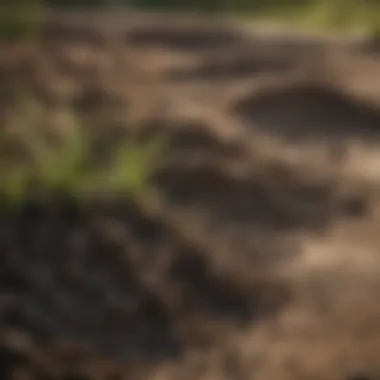
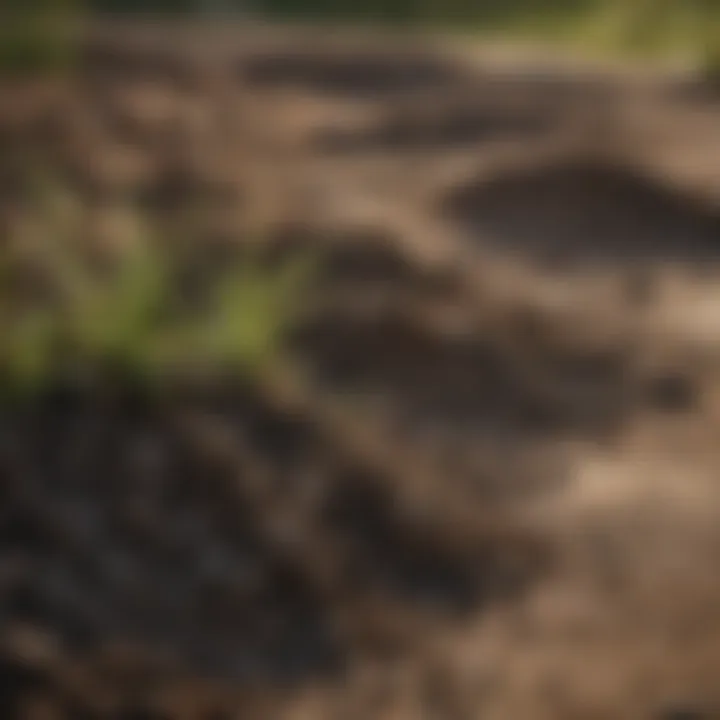
However, one needs to be careful about the timing of application. It's best to spread gypsum on damp soil, ideally after rainfall or irrigation, to increase its efficiency. As each situation is unique, testing soil before implementing any comprehensive treatment can offer valuable insights.
Overseeding Techniques
Overseeding is another powerful method to revive those sad, discolored patches of grass. By sowing new grass seed directly into existing turf, overseeding can thicken up the lawn and restore a vibrant green look, offering a quick fix for unsightly urine spots.
- Steps for Effective Overseeding:
- Mow the lawn low: This helps the new seed make good contact with the soil, increasing germination prospects.
- Aerate the soil: This step lets seeds penetrate deeper, getting them established well.
- Select the right seed mix: Choose grass varieties that suit your region’s climate and the existing grass type.
The added benefit of overseeding is that it can enhance the lawn's resilience against future damage. A denser lawn can better handle various stressors, including urine spots, leading to an overall healthier yard.
Using Lawn Repair Products
Utilizing lawn repair products can be the cherry on top when trying to mitigate urine damage. There are specialized mixes available on the market designed to soothe and restore damaged areas efficiently.
Here are a few factors to consider when selecting lawn repair products:
- Choose a quality brand: Researching and reading reviews on different products can help narrow down the best options for your specific needs.
- Consider product composition: Look for products that balance nutrients effectively, ensuring they meet specific deficiencies in your lawn. Bonus points if they provide resistant strains of seed that withstand harsh conditions.
Lawn repair products can often be combined with other methods, such as overseeding or applying gypsum, but it’s crucial to follow the manufacturer’s instructions for best results. Just remember, consistency in treatment can yield freedom from those pesky spots over time.
"Understanding how to tackle urine spots is essential for maintaining the integrity of your lawn; it’s not just about appearance but overall health too."
In summary, addressing urine spots on lawns using these methods can yield positive results. Whether it's applying gypsum, trying overseeding, or utilizing lawn repair products, these strategies can offer a pathway back to a thriving green area.
Environmental Considerations
Lawn care is often seen through the narrow lens of aesthetic appeal, but there’s more beneath the surface. When dealing with urine spots on lawns, it's essential to dive into environmental considerations. This aspect is not just about the immediate appearance of the grass; it encompasses broader ecological impacts that affect soil health and a sustainable ecosystem.
Impact on Soil Health
Urine, with its distinctive chemical profile, can have a profound effect on soil health. High levels of nitrogen can stimulate grass growth, yet when concentrated too much, it leads to soil degradation rather than enhancement. This excess nitrogen causes leaching, where vital nutrients are washed away from the topsoil during heavy rains. Over time, this leaching can diminish the soil’s fertility and alter its microbial balance.
Key aspects to watch for include:
- Soil pH Imbalance: Frequent spots of concentrated urine can lower soil pH. This makes soil more acidic, which can hinder the growth of certain beneficial bacteria, disturbing the natural balance.
- Nutrient Deficiency: With consistent nitrogen spikes followed by leaching events, the soil can lose potassium and phosphorus, essential nutrients for grass growth that promote a robust root system.
Maintaining healthy soil isn't just about addressing urine spots; it's about fostering an environment where all plants can thrive. Understanding these dynamics allows lawn caretakers to make informed decisions.
Sustainable Lawn Practices
Introducing sustainable practices around lawn care can mitigate the detrimental effects of urine spots and promote a healthier ecosystem. There are various strategies that can be adopted:
- Deep Root Watering: Encouraging deep root growth through infrequent but deep watering helps grass bounce back from urine damage and reduces dependency on quick nutrient flushes.
- Incorporating Organic Matter: Regularly adding compost improves soil structure and provides a balanced nutrient supply, serving as a buffer against urine's harsh impacts.
- Diverse Planting: Growing a mixture of grass species can enhance resilience against urine spots. Certain grasses may be more tolerant of nitrogen than others, creating a diverse lawn that withstands the effects better.
Implementing these practices contributes not just to the aesthetics of your lawn but to the overall health of your garden environment. A healthy lawn becomes a natural habitat for beneficial insects and microorganisms.
By marrying carpet-like green aesthetics with proactive soil management, backyard caretakers can ensure the longevity of their lawns. It's not about simply patching up spots; it’s about fostering a full-circle approach to lawn care that acknowledges and respects the ecological implications of our practices.
Finale
Summary of Key Points
To synthesize the insights offered in this discussion, let’s recap the main aspects:
- Nature of the Problem: Urine spots appear due to the concentration of nitrogen, salts, and other elements in pet urine. This can lead to noticeable damage to grass.
- Chemical Composition: Urine typically has high nitrogen content which can cause immediate stress on grass, triggering burn spots while potentially overriding nutritional needs of the soil.
- Grass Recovery: Effective strategies such as watering techniques and soil amendments can help restore damaged areas, allowing grass the chance to heal.
- Preventive Measures: Training pets and carefully planning lawn maintenance can mitigate the chances of creating urine spots.
- Environmental Considerations: Maintaining a sustainable lawn involves recognizing the relationship between soil health and urine composition, understanding that our practices today can affect the ecosystem tomorrow.
"Prevention is better than cure," a simple phrase, yet it holds true deeply in lawn care as well. By understanding the sources of damage and acting proactively, we can keep our lawns vibrant and flourishing.
Final Thoughts for Lawn Caretakers
For lawn caretakers, the road ahead involves both a careful hands-on approach and a wider perspective of how interactions with nature play out. It’s not just a matter of aesthetics; the vitality of your lawn can signal the health of your local ecosystem.
Consider experimenting with resistant grass types that require less frequent watering or nitrogen. Aim for a lawn that can withstand the trials posed by household pets, yet remains lush and appealing. Educating yourself on soil health and sustainable practices can only bring you benefits in the long run.



